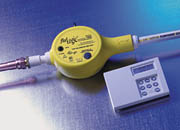Over the past year, in-line, whole-house water monitors and shut-off devices have been winning their place in America's buildings and in the hearts of insurance companies nationwide. These devices can be programmed to turn off a building's water supply when flow parameters are exceeded, for instance, in the event of a ruptured water line, an unusually long-running plumbing appliance, or even the small leakage caused by a ruptured ice maker supply line.

What's the Big Deal?
To give you an idea of the magnitude of damage even a small leak can cause, let's look at just one example. A cracked ice maker supply line left unattended for three hours will dump over 175 gallons of water into the walls of a building, where it will be wicked up into the walls, carpets, and framing, potentially setting the stage for the growth of mold or rot and structural degradation of the building materials. A three-hour ice maker supply line leak is the equivalent of dumping three 55-gallon drums of water on a kitchen floor. Though catastrophic leaks and plumbing failures can usually be addressed with the naked eye, it is the insidious small leaks like the one mentioned above that can be more damaging and harder if not impossible to notice before major damage has been done.Insurance Companies Are Taking Notice
According to insurance industry reports, property damage in the U.S. resulting from plumbing leaks is second only to hurricanes as the most costly insurance claim. Burst washing machine hoses constitute one of the most common sources of residential water damage, accounting for more than $150 million in claims each year in the U.S. Frozen water pipes contribute an estimated $400-500 million a year.
Mold: A Growing Concern
Insurance companies are also concerned about mold. Many types of household molds--including mycotoxins like stachybotrys (a.k.a. "Killer Mold" or "Toxic Mold")--can thrive where building materials that contain cellulose mix with water from leaky or broken pipes and faulty plumbing fittings (building materials that contain cellulose include ceiling tiles, wood and wood products, wallpaper, insulation materials, and drywall). In many cases, toxic mold can be completely prevented by depriving it of water, and the most common source of water in households is leaky pipes/water damage or problems with "building envelope" design. In-line, whole-house water monitors and shut-off devices can detect leaks or catastrophic failure, mitigate most if not all of the conditions that give rise to these insurance claims, and entirely prevent one of the two conditions that allow mold to thrive.How Flow Detection Works
To show how whole-house water monitors and shut-off devices work, let's take a look at the FloLogic System 2000, a product invented, patented, manufactured and sold by Raleigh, N.C.-based FloLogic, Inc. When installed in the main water line, whole-house shut-off devices like the FloLogic System 2000 monitor water flow continuously, are capable of detecting water flow down to ounces per minute, and even can trigger the automatic shut-off of the main line water flow. The FloLogic System 2000 consists of a water flow sensor and motor-driven ball valve that is installed in the building's water supply, monitored by an LCD controller. The sensor inside the flow path tells the controller when water is flowing into the building from the street or well at any given moment. Alphanumeric LCD displays similar to those found on electronic thermostats and security systems, allow these devices to be programmed very simply with a keypad for certain flow parameters and tolerances, based on water volume or time. Units normally come with a battery backup, which provides power for many hours of continuous operations in the event of a power outage.